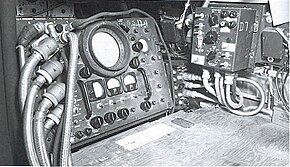 Typical H2X installation, opposite the radio operator's position. | |
| Country of origin | USA |
|---|---|
| Type | air-to-ground radar system[1] |
H2X, eventually designated as the AN/APS-15,[2] was an American ground scanning radar system used for blind bombing during World War II. It was developed at the MIT Radiation Laboratory under direction of Dr. George E. Valley Jr.[3] to replace the less accurate British H2S radar, the first ground mapping radar to be used in combat.[4] H2X was also known as the "Mickey set"[5] and "BTO" for "bombing through the overcast" radar.[6]
H2X differed from the original H2S primarily in its 3-cm wavelength X band rather than H2S' 10-cm S band. This shorter wavelength gave H2X higher resolution than H2S, allowing it to provide usable images over large cities which appeared as a single blob on the H2S display. The Royal Air Force (RAF) initially considered using H2X as well, but would instead develop their own X band system, the H2S Mk. III. The RAF system entered service in late 1943, before the first use of H2X in early 1944.
The desire for even higher resolution, enough to image individual docks and bridges, led to a number of variations on the H2X system, as well as the more advanced AN/APQ-7 "Eagle" system. All of these were replaced in the post-war era with systems customized for the jet powered strategic bombers that entered service.
- ^ Steven K. Bailey (March 2019). Bold Venture: The American Bombing of Japanese-Occupied Hong Kong, 1942-1945. U of Nebraska Press. pp. 207–. ISBN 978-1-64012-162-1.
- ^ L Brown (1 January 1999). Technical and Military Imperatives: A Radar History of World War 2. CRC Press. pp. 548–. ISBN 978-1-4200-5066-0.
- ^ Buderi, Robert (1996). The invention that changed the world (first ed.). New York, NY: Simon & Schuster. pp. 1–478. ISBN 0-684-81021-2.
- ^ Jablonski, Edward (1971). Volume 2 (Wings of Fire), Book I (Kites over Berlin). Airpower. p. 49.
- ^ Kevin A. Mahoney (20 August 2015). Bombing Europe: The Illustrated Exploits of the Fifteenth Air Force. Voyageur Press. pp. 239–. ISBN 978-0-7603-4815-4.
- ^ Claus Reuter (June 2000). The Development of the Heavy Bomber 1918 - 1944, Aaf. German Canadian Museum of. pp. 74–. ISBN 978-1-894643-12-2.
